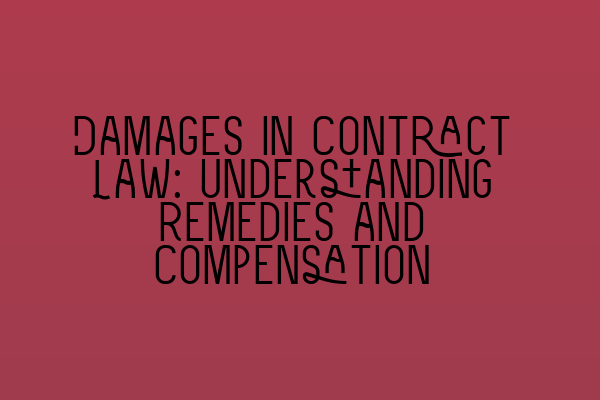Damages in Contract Law: Understanding Remedies and Compensation
Contracts are the foundation of business transactions and agreements, providing a legally binding framework for parties to meet their obligations. However, not all contracts run smoothly, and disputes can arise when one party fails to fulfill their contractual duties. In such cases, the injured party may seek remedies, typically in the form of damages.
What are Damages?
Damages refer to the monetary compensation awarded to the injured party to compensate for the loss or harm suffered as a result of the breach of contract. The purpose of damages is to put the injured party in the same financial position they would have been in if the breach had not occurred.
There are various types of damages available in contract law, each serving a different purpose. It’s essential to understand these remedies to effectively pursue a claim or defend against one. Let’s explore the four primary categories of damages:
1. Compensatory Damages
Compensatory damages aim to reimburse the injured party for the actual loss or harm suffered due to the breach of contract. This form of damages covers both direct and consequential losses.
Direct losses are those that arise naturally from the breach and can be reasonably foreseen by both parties at the time of entering into the contract. For example, if a supplier fails to deliver merchandise on time, resulting in lost sales for the buyer, the buyer may seek compensation for the lost profits.
Consequential losses, on the other hand, are those that do not arise naturally but are reasonably foreseeable as a result of the breach. For instance, if the buyer fails to receive the goods on time, leading to a breach of their own contract with their customer, they may seek damages to cover the loss suffered due to the breach of their own contract.
2. Expectation Damages
Expectation damages aim to place the injured party in the position they would have been in if the breaching party had fulfilled their obligations under the contract. These damages typically cover any loss of expected profits, as well as any other benefits that the injured party would have received if the contract had been performed as agreed.
For example, if a construction company fails to complete a project according to the agreed-upon specifications, the injured party may be entitled to expectation damages, which would reimburse them for the additional costs incurred to rectify the construction issues.
3. Liquidated Damages
Liquidated damages are predetermined or agreed-upon damages specified in the contract itself, which both parties acknowledge as the amount payable in case of a specific breach. These damages are often used in contracts where the exact extent of the potential loss is difficult to determine at the time of entering into the agreement.
For instance, in a construction contract, the parties may agree that if the project is not completed by the specified deadline, the contractor will pay a predetermined amount per day as liquidated damages to the client. This provision serves as an incentive for the contractor to complete the project on time, as the potential losses are clear and predetermined.
4. Restitutionary Damages
Restitutionary damages aim to restore the injured party to the position they were in before they entered into the contract. These damages typically arise in cases where there has been a total failure of consideration, meaning that one party has received no benefit from the contract.
For example, if a buyer pays for goods that are never delivered, the injured party may seek restitutionary damages, which would require the seller to return the money paid by the buyer.
The Calculation of Damages
The calculation of damages in contract law can be a complex process, as it requires determining the actual loss suffered by the injured party. The general principle is that damages should compensate and not punish, focusing on the actual losses rather than punitive measures.
When calculating damages, the court considers several factors, including:
- The nature of the breach
- The extent of harm suffered
- The reasonable foreseeability of the loss
- Any mitigating actions taken by the injured party
In some cases, the injured party has a duty to mitigate their losses, meaning they must take reasonable steps to minimize the harm caused by the breach. Failure to mitigate damages may limit the amount of compensation awarded.
Conclusion
Damages play a vital role in contract law, providing a means of compensation for parties who have suffered harm or loss due to a breach of contract. Understanding the different types of damages available and the calculation process is crucial for both plaintiffs and defendants in contract disputes.
If you are preparing for the SQE Contract Law exam, be sure to check out our related articles:
